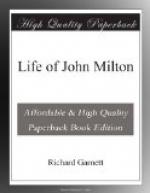Except for his formal incorporation with the University of Oxford, by proceeding M.A. there in 1635, and the death of his mother on April 3, 1637, Milton’s life during his residence at Horton, as known to us, is entirely in his writings. These comprise the “Sonnet to the Nightingale,” “L’Allegro,” “Il Penseroso,” all probably written in 1633; “Arcades,” probably, and “Comus” certainly written in 1634; “Lycidas” in 1637. The first three only are, or seem to be, spontaneous overflowings of the poetic mind: the others are composed in response to external invitations, and in two instances it is these which stand highest in poetic desert. Before entering on any criticism, it will be convenient to state the originating circumstances of each piece.
“Arcades” and “Comus” both owe their existence to the musician Henry Lawes, unless the elder Milton’s tenancy of his house from the Earl of Bridgewater can be accepted as a fact. Both were written for the Bridgewater family, and if Milton felt no special devotion to this house, his only motive could have been to aid the musical performance of his friend Henry Lawes, whose music is discommended by Burney, but who, Milton declares:
“First taught our English
music how to span
Words with just note and accent.”
Masques were then the order of the day, especially after the splendid exhibition of the Inns of Court in honour of the King and Queen, February, 1634. Lawes, as a Court musician, took a leading part in this representation, and became in request on similar occasions. The person intended to be honoured by the “Arcades” was the dowager Countess of Derby, mother-in-law of the Earl of Bridgewater, whose father, Lord Keeper Egerton, she had married in 1600. The aged lady, to whom more than forty years before Spenser had dedicated his “Teares of the Muses,” and who had ever since been an object of poetic flattery and homage, lived at Harefield, about four miles from Uxbridge; and there the “Arcades” were exhibited, probably in 1634. Milton’s melodious verses were only one feature in a more ample entertainment. That they pleased we may be sure, for we find him shortly afterwards engaged on a similar undertaking of much greater importance, commissioned by the Bridgewater family. In those days Milton had no more of the Puritanic aversion to the theatre—
“Then to the well-trod stage
anon,
If Jonson’s learned
sock be on,
Or sweetest Shakespeare, Fancy’s
child,
Warble his native wood-notes
wild,”




